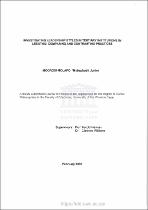| dc.contributor.advisor | Herman, Harold | |
| dc.contributor.author | Mooroshi-Molapo, Mabaphuthi Junior | |
| dc.date.accessioned | 2022-08-01T11:47:56Z | |
| dc.date.available | 2022-08-01T11:47:56Z | |
| dc.date.issued | 2005 | |
| dc.identifier.uri | http://hdl.handle.net/11394/9186 | |
| dc.description | Philosophiae Doctor - PhD | en_US |
| dc.description.abstract | The study investigated the leadership styles used in the Lesotho tertiary institutions. The research was undertaken at two institutions - Lerotholi Polytechnic and the National Teacher Training College. The population of the study is the lecturers and the leaders in the management position in the two institutions. The study discusses educational leadership and educational organizations and how they help towards the achievement and objectives. It is revealed that knowledge of educational management and educational institutions is necessary for leaders of the institutions. The discussion pointed out that activities run smoothly towards the achievement of goals and objectives under good management and leadership. The leadership styles are discussed focusing on their advantages and disadvantages. The conclusion drawn is that leadership styles are situational. Each styles can be used depending on the situation that prevails. Various appraisal models are also discussed focusing on their strengths and weaknesses. It is discovered that using a combination of appraisal models work best.
work best. Combining the mode calls for a face to -fare discussion between the leader and the lecturer. Questionnaires were employed to collect quantitative and qualitative data. The preferred and practised styles are compared and contrasted to determine whether or not they are used to achieve goals and objectives of the lecturers and the organizations. The data collected reflected that the leaders at Lerotholi
Polytechnic are more democratic and have a higher concern for the lecturers and production than the leaders at the National Teacher Training College. However, in both institutions, the order of preference of the leadership styles was the same. The first preferred was the democratic style. The second was the consultative style. The third was the autocratic style. The fourth was the laissez-fair style. The study ends by making recommendations that encourage high concern for production, the lecturers and the institutions resulting in sustainable ways of achieving the goals and objectives of the institutions and the lecturers. The recommendations contribute towards the academic and professional development of the lecturers and their institutions. The study specially recommends the Self and Institution Improvement Model (SIIM) adopted from the Department for Education and Employment (1997). The SIIM has an entrance interview before any lecturer gets into the system of the institution. On entering, each lecturer operates in a system that runs in a cyclical form that touches at four
points of commitment, planning, action, and evaluation during own life in the institution. The model ends with an exit interview that encourages any resigning lecturer to reflect on own life in the institution revealing the positive and negative experiences. This is done for the purpose of improving the leadership styles practised. | en_US |
| dc.language.iso | en | en_US |
| dc.publisher | University of the Western Cape | en_US |
| dc.subject | Tertiary education | en_US |
| dc.subject | Organizational goals | en_US |
| dc.subject | Organizational objectives | en_US |
| dc.subject | Educational management | en_US |
| dc.subject | Educational administration | en_US |
| dc.subject | Leadership | en_US |
| dc.subject | Leadership styles | en_US |
| dc.subject | Team building | en_US |
| dc.subject | Appraisal | en_US |
| dc.subject | Formal and informal groups | en_US |
| dc.title | Investigating leadership styles in tertiary institutions in Lesotho: Comparing and contrasting practices | en_US |
| dc.rights.holder | University of the Western Cape | en_US |

